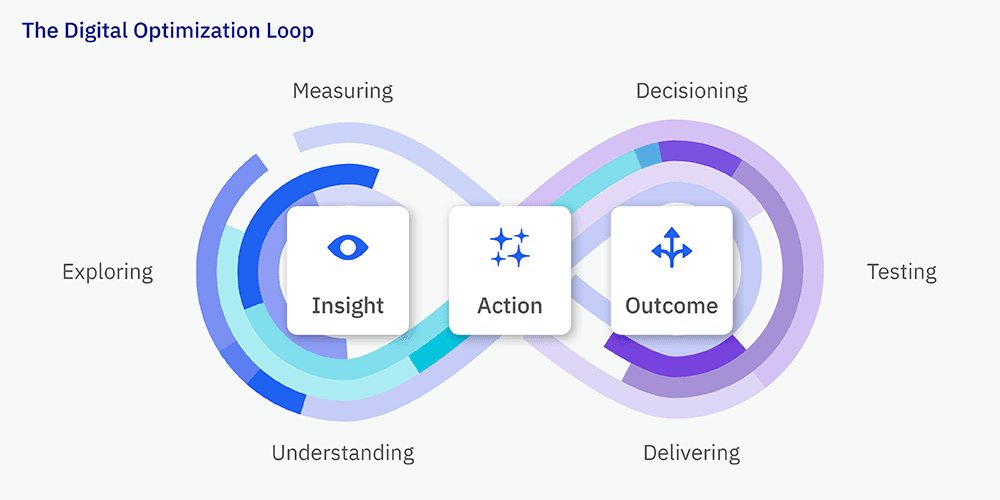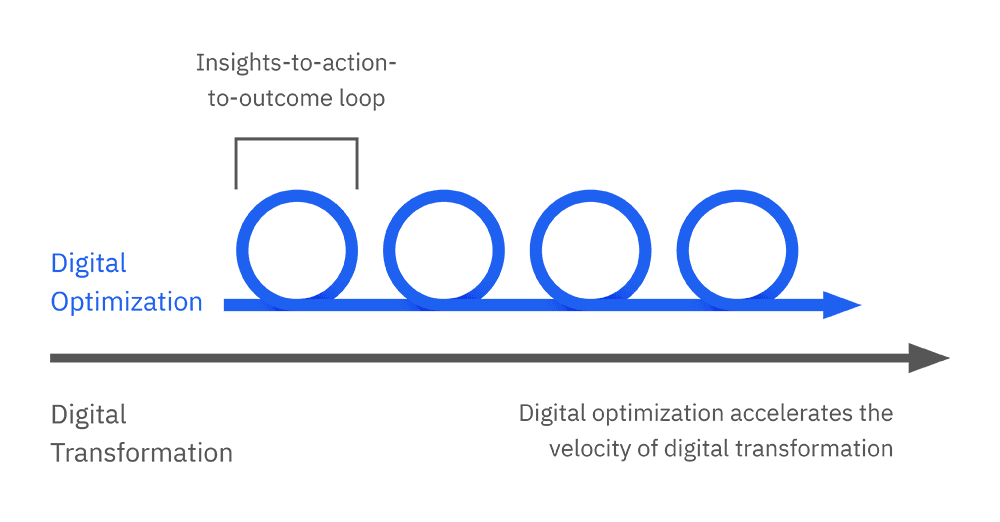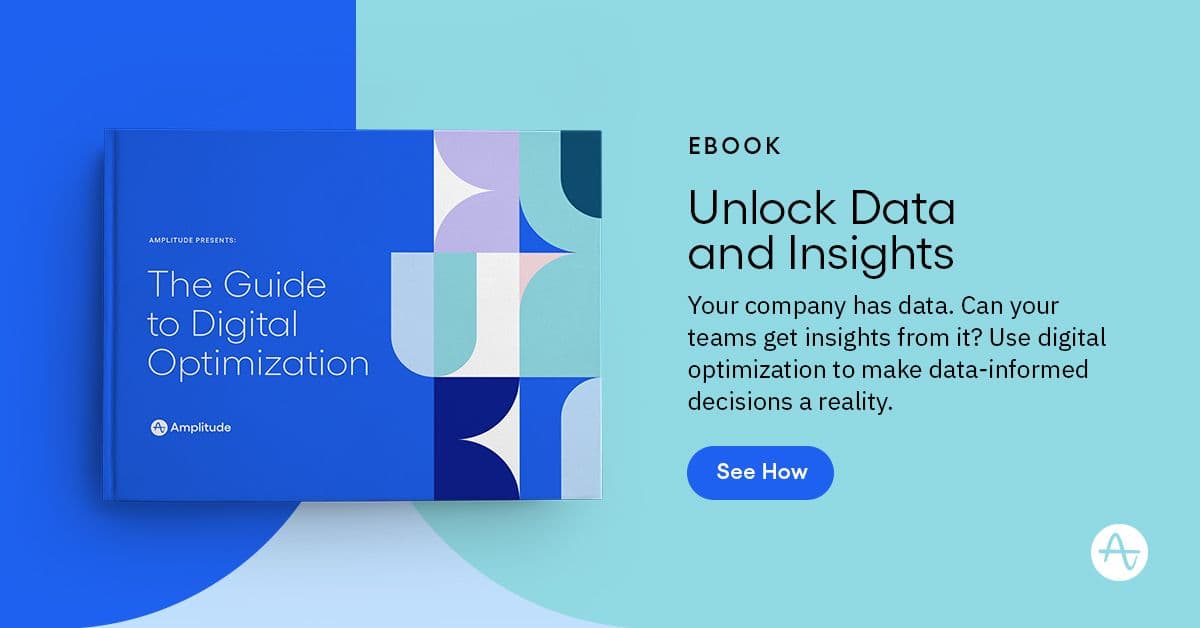Digital Optimization vs. Digital Transformation Explained
Learn the difference between digital optimization and digital transformation and how to embrace the movements for the benefit of your business.
Digital optimization and digital transformation are two concepts that help organizations prepare for, adapt to, and embrace the evolving business landscape.
While these two motions overlap in many ways, they are not in conflict. A digital transformation investment often raises the need for digital optimization, and a digital optimization investment often accelerates digital transformation.
Any business focused on driving product-led growth should consider applying both concepts to their organization-wide strategies. Digital transformation brings about new products, and digital optimization improves them.
Key takeaways
- Digital transformation and digital optimization occur in parallel.
- Digital transformation is table stakes for any business.
- Digital optimization is a new way of working, which reinforces a growth loop of insight-to-action-to-outcome.
- Digital optimization can’t happen without the critical product data that digital transformation produces in the first place.
What is digital optimization?
Digital optimization is a set of practices and tools for optimizing the value of your digital investments, with a focus on driving sustainable growth, customer value, and innovation.
Digital optimization empowers teams to take immediate action based on critical product insights. It’s a way of working that breaks down the barriers and silos that prevent teams from moving fast. With digital optimization in play, your team gathers more insights, implements more changes, and sees more impactful outcomes in the same time that your competitors are stuck wondering what works in the first place.
When done right, teams that operate with digital optimization cycle through these key phases:
- Data to insight
- Insight to action
- Action to outcome
These phases act as a series of growth loops, accelerating innovation in the product experience. This means teams are able to drive sustainable growth and new revenue streams from the product data.

What is digital transformation?
Of course, the critical product data that enables digital optimization doesn’t exist without digital transformation. Digital transformation is the ongoing process of rethinking your business around digital. Oftentimes, this involves deploying new digital products and services to meet demonstrated customer preferences and business opportunities (read more about digital transformation examples).
These new products create digital touchpoints with the customer, which reveal opportunities to improve the overall customer experience. With the influx of new data, products, and customer touchpoints, it’s at this point that digital transformation prompts the need for digital optimization.

While digital transformation is focused on building new digital products, digital optimization is focused on using the product data from those new products to make strategic decisions, accelerate innovation, and increase the value of those digital transformation efforts.
Both strategies occur in parallel, and the growth/feedback loop from digital optimization (insight to action to outcome, repeat) accelerates the ongoing digital transformation.
How digital transformation supports digital optimization
In digital optimization, each customer-facing team—product, marketing, customer success, engineering, analysts, and more—cycle through the insight-action-outcome loop to turn product data into valuable outcomes. With each new insight comes an opportunity to drive a valuable business outcome. With each outcome comes more data to provide deeper insights.
This feedback loop of data/insight/action can’t occur without a digital transformation effort in the first place. Digital transformation means bringing in new technological solutions to create a fundamental shift in your organization. This could involve reimagining:
- Your offerings (products and services)
- Your business operations
- Your organizational culture
It’s in this change management of people, processes, and technology that digital transformation becomes a digital optimization effort too. To optimize your digital investments, you need to make sure that teams have access to trustworthy and accurate data. In addition, teams should be empowered to make decisions and take actions that improve valuable metrics, like customer engagement and retention. This, in practice, is digital optimization.
Here’s what digital optimization looks like in reality, throughout the aforementioned growth loop:
Data to Insight
- Digital teams have access to product data.
- There is a single source of truth for digital insights.
- The product data is trustworthy and compliant with data privacy.
- Teams have full visibility into the customer journey.
- Data, analytics, and digital experience tools are self-service.
- Teams are collaborative across the organization.
Insight to Action
- Teams use data to build great products experiences faster.
- High-impact experimentation is encouraged.
- Data-driven product decisions are made.
- Time to market and the need for speed are emphasized.
- Teams can iterate confidently with feature management.
Action to Outcome
- Teams optimize the outcomes of digital experiences.
- Conversion is improved.
- The organization produces a product-led growth engine.
- There is audience segmentation and activation.
- Customer retention and lifetime value increase.
With a digital optimization strategy, teams are collaborative: They share insights and have uninhibited access to a complete view of the customer journey. Product data sits at the center of decision-making, and the insights that drive actions follow.
What’s a real-world example of digital optimization?
Consider the story of Kahoot!. The quiz and trivia platform was founded in 2012 with a focus on the classroom. By 2021, Kahoot! had reached more than 5 billion players—expanding beyond the classroom and taking hold of the business world, too. Now, 97 percent of Fortune 500 companies use Kahoot! for training, presentation, events, and more.
How did Kahoot! get there? By ensuring every team has access to product data to make decisions.
“We put a lot of time into creating self-service analytics that allow people across the company to use product data for analysis by themselves,” said Kahoot!’s Head of Data, Martí Colominas. He continued:
That means that engineers, PMs, and marketers can understand how our users use the product or how the features we release are performing without having to rely on the data team for everything… It’s impossible to overemphasize the importance of self-service analytics in all of these cases. We’ve removed that classic data bottleneck you see at so many companies, where it takes two weeks for someone to receive a report. The immediacy of insights sparks further curiosity.
This practice of digital optimization is critical to helping the teams at Kahoot! determine how they bring value to customers and where to expand their efforts. Bringing shared data and common visibility to every team is a business-critical requirement for digital optimization.
Bring digital optimization to your business
Digital transformation—rethinking your business around digital—is table stakes for any company these days. But when your organization embraces digital optimization too, digital transformation efforts become more effective. You can:
- Connect products to revenue
- Out-innovate the competition
- Create a data-driven culture
- Ship product features faster
- Understand digital customer behavior
And more.
But it all starts with a foundation of knowledge. To see more examples, diagrams, and best practices, continue your reading with Amplitude’s Guide to Digital Optimization today.
References
- Salesforce: What Is Digital Transformation?
- Amplitude: S-1 and Digital Optimization Guide
- Gartner: Digital Optimization

Mallory Busch
Former Senior Content Marketing Manager, Amplitude
Mallory Busch formerly ran the Amplitude blog, frequently named a best blog for product managers. She also created AmpliTour, the live workshop for beginners to product analytics and 6 Clicks, the Amplitude video series. She produced the Flywheels Playbook, wrote The Product Report 2021 and produced The Product Report 2022. A former developer and journalist, Mallory's written work and coding projects have been published by TIME, Chicago Tribune, and The Texas Tribune. She graduated from Northwestern University.
More from Mallory





